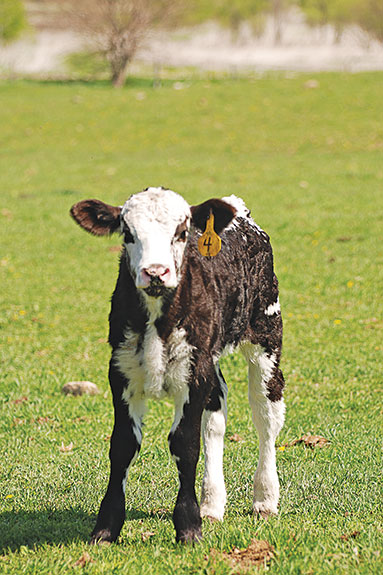The calf receives immune protection when it drinks colostrum. It’s the immunoglobulins or IgGs in the colostrum that provides immune protection.
IgGs travel through the calf and are absorbed through the intestinal wall into the bloodstream.
A number of situations may arise during calving season that put a calf in a position where it does not have access to high-quality colostrum.
Situations that can impact whether or not a calf will have access to high-quality colostrum include if the dam has a body condition score below 6, difficult calving, a hot summer or a harsh cold winter, first-calf heifers and orphaned calves. (Click here and read more information on how these situations can impact colostrum quality.)
In order to provide the calf with the immune protection it needs, despite any situation that may arise, it can be helpful to have a colostrum replacer on hand. It is important to note that not all colostrum replacers are created equal.

Here’s a look at questions to ask prior to selecting a colostrum replacer:
Is it a true colostrum replacement or is it a colostrum supplement?
There is a difference between a colostrum replacer and a colostrum supplement. A colostrum replacer is designed to be fed as the calf’s only source of colostrum in the event that no high-quality colostrum is available (i.e., orphaned calf).
A colostrum replacer can also be used as a booster for the dam’s colostrum by using a fraction of the full dose. This can be helpful if the quality of colostrum from the dam is in question (i.e., first-calf heifers or stressed cows).
On the other hand, a colostrum supplement is designed to boost the quality of collected colostrum. Make sure to look for a colostrum replacement.
Is it made from real bovine colostrum or is it made from blood serum collected at the slaughterhouse?
Products preferred are listed as real colostrum that has been collected from dairy cattle that has been dried down and heat-treated to eliminate any harmful agents.
Serum products are built from the ground up using collected blood as the source of antibodies for the calf. These products can be effective in transferring immunity to the calf, but they can be short on soluble factors and maternal cells present in maternal colostrum.
The calf depends on these other factors and cells to create an immune response that will last until its own immune system is fully functioning.
Serum replacers also lack colostral fat, which is very energy-dense and is well digested by the calf. Serum products typically use animal fat or vegetable fat, which are less digestible.
Some colostrum-based products have some or all of this valuable colostral fat removed – so look for the full fat products (greater than 20 percent colostral fat).
Verify if the immunoglobulins in the colostrum are from actual colostrum or from alternative sources such as blood or serum. The cost will be $25 to $45 per dose and you get what you pay for in quantity and quality of the IgG in the product. Dried USDA-licensed colostrum with high IgG levels will cost more.
How much fat is in the colostrum replacer?
High-quality colostrum will contain between 24 to 32 percent solids and have a fat content of 6.7 percent, which is 20 percent to 28 percent on a dry basis. A colostrum replacer should be at least 20 percent colostral fat.
The fat content of a colostrum replacer plays a critical role in the first few hours of life, as the newborn calf has little to no energy reserves in the bank.
The fat in the colostrum supplies the calf with the energy it needs to maintain body temperature and help fight off pathogens. Colostral fat also has anti-microbial functions and can bind rotavirus and E. coli – two of the main causes of calf diarrhea.
Look for a colostrum replacer that provides about 100 grams of colostral fat. This level of fat provides sufficient energy for almost 12 hours of thermoneutral temperatures and more than eight hours of cold (14ºF).
Is the product labeled with a claim for bovine IgG or just globulin proteins?
IgG, more specifically IgG1, are the actual antibodies that protect the young calf from pathogens that may cause scours and respiratory diseases. Calves should receive at least 100 grams of IgG to receive adequate immunity from the colostrum.
Globulin proteins are comprised of a variety of other proteins as well as the IgG antibodies. It is nearly impossible to know what percentage of the globulin protein is IgG by looking at the package.
A product could be labeled as providing 130 grams of globulin protein but may contain much less than the crucial 100 grams of IgG needed by the calf.
Look for a colostrum replacer that contains at least 100 grams of actual IgG, not just globulin protein per dose. This level of IgG is sufficient to prevent failure of passive transfer, and with 1 to 2 quarts of additional maternal colostrum, provides calves with optimal passive transfer levels.
Is the product licensed by the USDA as a total replacement for maternal colostrum?
Only products licensed as Veterinary Biologics by the USDA have production methods assured by the USDA to be free of infectious agent transmission.
Some serum-based replacers will use blood from USDA-certified slaughterhouses. Replacer products containing this blood have never been tested by the USDA for effectiveness in transferring immunity to calves.
A USDA-licensed colostrum replacement can ensure calves are getting the crucial energy and antibodies they need the first 12 hours of life.
Does the colostrum replacer require one dose or multiple doses?
A colostrum replacer that requires more than one dose may prevent the calf from receiving all of the IgGs it needs within the timeframe it needs them. Remember, a calf starts to lose its ability to absorb IgGs almost immediately after birth.
Be aware of the number of doses required and the timeframe they should be given in. If the full number of doses is not given to the calf, it could be put at risk. Look for a colostrum replacer that conveniently provides the amount of IgGs needed in one dose. ![]()
Tom Earleywine has a Ph.D. in dairy science from the University of Wisconsin – Madison and is director of nutritional services for Land O’Lakes Animal Milk Products.
PHOTO
The calf depends on these other factors and cells to create an immune response that will last until its own immune system is fully functioning. Photo courtesy of Land O’Lakes Animal Milk Products.







